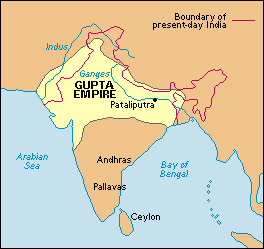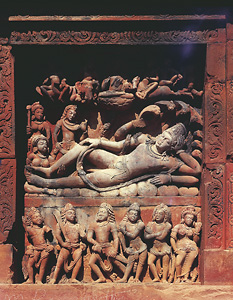Gupta, << GUHP tuh or GUP tuh, >> dynasty was a series of rulers of one family who reigned in what is now northern India and Bangladesh from about A.D. 320 to about 500. During the Gupta period, India’s literature, sculpture, and other arts reached high levels of accomplishment. Textile manufacturing and trade, particularly with Southeast Asia and China, both flourished.

Rise and fall of the dynasty.
The Gupta family of rulers gained control of Magadha, a small kingdom in the Ganges Valley. Chandragupta I, who reigned from about 320 to about 335, established the dynasty’s prestige and expanded its territory through marriage and war. Samudragupta, who ruled from about 335 to about 375, and his successor, Chandragupta II, who governed until about 415, seized much additional territory in the Ganges and Indus valleys. They also forced many rulers along India’s coastlines to submit to their power.
After 450, Huns from central Asia increasingly attacked the empire. Skandagupta, who ruled from about 454 to 467, defeated many Hun invaders and put down revolts by regional rulers. The Huns finally pierced the Gupta defenses about 500 and eventually conquered much of northern India. But small kingdoms, whose rulers claimed descent from the Gupta dynasty, lasted in eastern India until the mid-500’s.
Though the Guptas called themselves emperors, their empire was loosely organized. They directly controlled the Ganges Valley, but outlying areas and regional rulers had much independence as long as they paid tribute to the Guptas. Even in the Ganges Valley, villages and cities chose their local officials and managed their own affairs.
Cultural life under the Guptas
received support from the prosperous upper classes of the cities, especially the capital city, Pataliputra. Most Gupta rulers were Hindus, but Hinduism, Buddhism, and Jainism all flourished in the empire. Under the Guptas, Hinduism developed many of the social and religious forms found today. For example, the image of a Hindu god or goddess became important as an object of worship. Images were offered food, bathed, and sung to.

During the Gupta period, music and dance developed the complex forms that are the basis of classical Indian music and dance. The detailed, yet restrained, Hindu and Buddhist sculpture of the Gupta period became the model for much of later Indian art. Some excellent examples decorate the Buddhist stupa (dome-shaped monument) at Sarnath. Gupta wallpaintings included scenes of Indian life and events in Buddha’s life. Most of the paintings that remain are in caves, such as those at Ajanta.
Sanskrit, India’s classical language, flowered during the Gupta era. Court and popular playwrights wrote both dramas and comedies, and all classes of people attended the theater. The famous poet and dramatist Kalidasa wrote about love among human beings, gods, and goddesses. Many of his works taught moral lessons.
Hindu schools and Buddhist monasteries taught astronomy, grammar, mathematics, medicine, philosophy, and religion. The Buddhist monastery at Nalanda held large libraries and attracted students of many religions from as far as China and Java. Gupta mathematicians invented the decimal system and the Hindu-Arabic numerals that most of the world uses today.
Indian culture and religious practices of the Gupta period spread to other regions. Many kings in Southeast Asia adopted the Sanskrit language and Hindu ceremonies for use in their courts.
